COVID-19 and Water Variables: Review and Scientometric Analysis
Abstract
1. Introduction
2. Methodology
2.1. Relation between COVID-19 and Water-Related Variables
2.2. Statistic Analysis of the Determinants of Scientific Productivity at the Country Level
3. Relationship between COVID-19 and Water-Related Variables
3.1. Wastewater
3.2. Renewable Water Resources
3.3. Freshwater Withdrawal
3.4. Access to Safe and Improved Drinking Water
4. Determinants of Scientific Productivity at the Country Level
4.1. Articles vs. COVID-19 Incidence
- All countries with published articles in the fields of COVID-19 and water;
- All collaborations between different countries (namely, researchers from different countries) are based on the average number of publications per year in 2020, 2021, and the beginning of 2022. The bigger the bullet, the higher the number of articles and collaborations.
4.2. Articles vs. COVID-19 vs. Water Variables
5. Conclusions
Author Contributions
Funding
Institutional Review Board Statement
Informed Consent Statement
Data Availability Statement
Conflicts of Interest
Appendix A. Histogram of the Dependent Variable—Articles

Appendix B. Histogram of the Logarithmic Transformation of the Dependent Variable—Larticles

References
- World Health Organization. Water, Sanitation, Hygiene and Waste Management for SARS-CoV-2, the Virus That Causes COVID-19: Interim Guidance; WHO: Geneva, Switzerland, 2020; WHO/2019-nCoV/IPC_WASH/2020.4. [Google Scholar]
- Larson, R. Water law and the response to COVID-19. Water Int. 2020, 45, 716–721. [Google Scholar] [CrossRef]
- Warner, M.E.; Zhang, X.; Rivas, M.G. Which states and cities protect residents from water shutoffs in the COVID-19 pandemic? Util. Policy 2020, 67, 101118. [Google Scholar] [CrossRef] [PubMed]
- Ludtke, D.U.; Luetkemeier, R.; Schneemann, M.; Liehr, S. Increase in Daily Household Water Demand during the First Wave of the COVID-19 Pandemic in Germany. Water 2021, 13, 260. [Google Scholar] [CrossRef]
- Kalbusch, A.; Henning, E.; Brikalski, M.P.; deLuca, F.V.; Konrath, A.C. Impact of coronavirus (COVID-19) spread-prevention actions on urban water consumption. Resour. Conserv. Recycl. 2020, 163, 105098. [Google Scholar] [CrossRef] [PubMed]
- Abu-Bakar, H.; Williams, L.; Hallett, S.H. Quantifying the impact of the COVID-19 lockdown on household water consumption patterns in England. NPJ Clean Water 2021, 4, 13. [Google Scholar] [CrossRef]
- Anim, D.O.; Ofori-Asenso, R. Letter to the editor: Water scarcity and COVID-19 in sub-Saharan Africa. J. Infect. 2020, 81, e108–e109. [Google Scholar] [CrossRef] [PubMed]
- Jiwani, S.S.; Antiporta, D.A. Inequalities in access to water and soap matter for the COVID-19 response in sub-Saharan Africa. Int. J. Equity Health 2020, 19, 82. [Google Scholar] [CrossRef] [PubMed]
- Zvobgo, L.; Do, P. COVID-19 and the call for ‘Safe Hands’: Challenges facing the under-resourced municipalities that lack potable water access—A case study of Chitungwiza municipality, Zimbabwe. Water Res. X 2020, 9, 100074. [Google Scholar] [CrossRef]
- Paplorey, C. The impact of the COVID-19 health crisis on the water cycle in France (L’impact de la crise sanitaire du COVID-19 sur le cycle de l’eau en France). La Houille Blanche 2020, 82, 8. [Google Scholar] [CrossRef]
- UNESCO. The United Nations World Water Development Report 2021: Valuing Water. 2021. Available online: https://unesdoc.unesco.org/ark:/48223/pf0000375724 (accessed on 7 March 2022).
- Haramoto, E.; Malla, B.; Thakali, O.; Kitajima, M. First environmental surveillance for the presence of SARS-CoV-2 RNA in wastewater and river water in Japan. Sci. Total Environ. 2020, 737, 140405. [Google Scholar] [CrossRef]
- Selvam, S.; Jesuraja, K.; Venkatramanan, S.; Chung, S.Y.; Roy, P.D.; Muthukumar, P.; Kumar, M. Imprints of pandemic lockdown on subsurface water quality in the coastal industrial city of Tuticorin, South India: A revival perspective. Sci. Total Environ. 2020, 738, 139848. [Google Scholar] [CrossRef] [PubMed]
- Muduli, P.R.; Kumar, A.; Kanuri, V.V.; Mishra, D.R.; Acharya, P.; Saha, R.; Biswas, M.K.; Vidyarthi, A.K.; Sudhakar, A. Water quality assessment of the Ganges River during COVID-19 lockdown. Int. J. Environ. Sci. Technol. 2021, 18, 1645–1652. [Google Scholar] [CrossRef] [PubMed]
- Molekoa, M.D.; Avtar, R.; Kumar, P.; Thu Minh, H.V.; Dasgupta, R.; Johnson, B.A.; Sahu, N.; Verma, R.L.; Yunus, A.P. Spatio-Temporal Analysis of Surface Water Quality in Mokopane Area, Limpopo, South Africa. Water 2021, 13, 220. [Google Scholar] [CrossRef]
- Baldovin, T.; Amoruso, I.; Fonzo, M.; Buja, A.; Baldo, V.; Cocchio, S.; Bertoncello, C. SARS-CoV-2 RNA detection and persistence in wastewater samples: An experimental network for COVID-19 environmental surveillance in Padua, Veneto Region (NE Italy). Sci. Total Environ. 2021, 760, 143329. [Google Scholar] [CrossRef] [PubMed]
- Sherchan, S.P.; Shahin, S.; Ward, S.; Tandukar, S.; Aw, T.G.; Schmitz, B.; Ahmed, W.; Kitajima, M. First detection of SARS-CoV-2 RNA in wastewater in North America: A study in Louisiana, USA. Sci. Total Environ. 2020, 743, 140621. [Google Scholar] [CrossRef]
- Westhaus, S.; Weber, F.A.; Schiwy, S.; Linnemann, V.; Brinkmanne, M.; Widera, M.; Greve, C.; Janke, A.; Hollert, H.; Wintgens, T.; et al. Detection of SARS-CoV-2 in raw and treated wastewater in Germany—Suitability for COVID-19 surveillance and potential transmission risks. Sci. Total Environ. 2021, 751, 141750. [Google Scholar] [CrossRef]
- Arora, S.; Nag, A.; Sethi, J.; Rajvanshi, J.; Saxena, S.; Shrivastava, S.K.; Gupta, A.B. Sewage surveillance for the presence of SARS-CoV-2 genome as a useful wastewater based epidemiology (WBE) tracking tool in India. Water Sci. Technol. 2020, 82, 2823–2836. [Google Scholar] [CrossRef]
- Kitajima, M.; Ahmed, W.; Bibby, K.; Carducci, A.; Gerba, C.P.; Hamilton, K.A.; Haramoto, E.; Rose, J.B. SARS-CoV-2 in wastewater: State of the knowledge and research needs. Sci. Total Environ. 2020, 739, 139076. [Google Scholar] [CrossRef]
- Larsen, D.A.; Wigginton, K.R. Tracking COVID-19 with wastewater. Nat. Biotechnol. 2020, 38, 1151–1153. [Google Scholar] [CrossRef]
- Tiwari, S.B.; Gahlot, P.; Tyagi, V.K.; Zhang, L.; Zhou, Y.; Kazmi, A.A.; Kumar, M. Surveillance of Wastewater for Early Epidemic Prediction (SWEEP): Environmental and health security perspectives in the post COVID-19 Anthropocene. Environ. Res. 2021, 195, 110831. [Google Scholar] [CrossRef]
- Hamadieh, Z.; Hamilton, K.; Silverman, A. Systematic review of the relative concentrations of noroviruses and fecal indicator bacteria in wastewater: Considerations for use in quantitative microbial risk assessment. J. Water Health 2021, 19, 918–932. [Google Scholar] [CrossRef] [PubMed]
- Ahmed, W.; Bivins, A.; Simpson, S.L.; Bertsch, P.M.; Ehret, J.; Hosegood, I.; Metcalfe, S.S.; Smith, W.J.M.; Thomas, K.V.; Tynan, J.; et al. Wastewater surveillance demonstrates high predictive value for COVID-19 infection on board repatriation flights to Australia. Environ. Int. 2022, 158, 106938. [Google Scholar] [CrossRef] [PubMed]
- Saawarm, B.; Hait, S. Occurrence, fate and removal of SARS-CoV-2 in wastewater: Current knowledge and future perspectives. J. Environ. Chem. Eng. 2021, 9, 104870. [Google Scholar] [CrossRef] [PubMed]
- Cuevas-Ferrando, E.; Perez-Cataluna, A.; Allende, A.; Guix, S.; Randazzo, W.; Sanchez, G. Recovering coronavirus from large volumes of water. Sci. Total Environ. 2021, 762, 143101. [Google Scholar] [CrossRef] [PubMed]
- Gwenzi, W. Leaving no stone unturned in light of the COVID-19 faecal-oral hypothesis? A water, sanitation and hygiene (WASH) perspective targeting low-income countries. Sci. Total Environ. 2021, 753, 141751. [Google Scholar] [CrossRef]
- Sanger, N.; Heinzel, C.; Sandholz, S. Advancing resilience of critical health infrastructures to cascading impacts of water supply outages–insights from a systematic literature review. Infrastructures 2021, 6, 177. [Google Scholar] [CrossRef]
- Bhowmick, G.D.; Dhar, D.; Nath, D.; Ghangrekar, M.M.; Banerjee, R.; Das, S.; Chatterjee, J. Coronavirus disease 2019 (COVID-19) outbreak: Some serious consequences with urban and rural water cycle. NPJ Clean Water 2020, 3, 32. [Google Scholar] [CrossRef]
- Achak, M.; Bakri, S.A.; Chhiti, Y.; Alaoui, F.E.M.; Barka, N.; Boumya, W. SARS-CoV-2 in hospital wastewater during outbreak of COVID-19: A review on detection, survival and disinfection technologies. Sci. Total Environ. 2021, 761, 143192. [Google Scholar] [CrossRef]
- Casado-Aranda, L.A.; Sanchez-Fernandez, J.; Viedma-del-Jesus, M.I. Analysis of the scientific production of the effect of COVID-19 on the environment: A bibliometric study. Environ. Res. 2021, 193, 110416. [Google Scholar] [CrossRef]
- Usman, M.; Ho, Y.S. COVID-19 and the emerging research trends in environmental studies: A bibliometric evaluation. Environ. Sci. Pollut. Res. 2021, 28, 16913–16924. [Google Scholar] [CrossRef]
- Sharma, G.D.; Tiwari, A.K.; Jain, M.; Yadav, A.; Srivastava, M. COVID-19 and environmental concerns: A rapid review. Renew. Sust. Energ. Rev. 2021, 148, 111239. [Google Scholar] [CrossRef]
- Ji, B.; Zhao, Y.; Wei, T.; Kang, P. Water science under the global epidemic of COVID-19: Bibliometric tracking on COVID-19 publication and further research needs. J. Environ. Chem. Eng. 2021, 9, 105357. [Google Scholar] [CrossRef]
- Soboji, A.O.; Zayed, T. Impact of sewer overflow on public health: A comprehensive scientometric analysis and systematic review. Environ. Res. 2022, 203, 111609. [Google Scholar] [CrossRef]
- Van Eck, N.J.; Waltman, L. Software survey: VOSviewer, a computer program for bibliometric mapping. Scientometrics 2010, 84, 523–538. [Google Scholar] [CrossRef] [PubMed]
- Van Eck, N.J.; Waltman, L. VOSviewer Manual for Version 1.6.17; CWTS Meaningful Metrics; Universiteit Leiden: Leiden, The Netherlands, 2021. [Google Scholar]
- Food and Agriculture Organization of the United Nations (FAO). Aquastat, Aquastat Database. 2022. Available online: https://www.fao.org/aquastat/statistics/popups/itemDefn.html?id=4269 (accessed on 7 March 2022).
- Food and Agriculture Organization of the United Nations (FAO). Aquastat, Aquastat Database. 2022. Available online: https://www.fao.org/aquastat/statistics/popups/itemDefn.html?id=4188 (accessed on 7 March 2022).
- Food and Agriculture Organization of the United Nations (FAO). Aquastat, Aquastat Database. 2022. Available online: https://www.fao.org/aquastat/statistics/popups/itemDefn.html?id=4263 (accessed on 7 March 2022).
- Food and Agriculture Organization of the United Nations (FAO). Aquastat, Aquastat Database. 2022. Available online: https://www.fao.org/aquastat/statistics/popups/itemDefn.html?id=4114 (accessed on 7 March 2022).
- United Nations Development Programme (UNDP). Human Development Report 2020—Human Development Index. Statistical Tables. 2022. Available online: http://hdr.undp.org/en/content/download-data (accessed on 7 March 2022).
- The World Bank. World Development Indicators–GDP per Capita (Current US$). Available online: https://data.worldbank.org/indicator/NY.GDP.PCAP.CD (accessed on 7 March 2022).
- Sangkham, S. A review on detection of SARS-CoV-2 RNA in wastewater in light of the current knowledge of treatment process for removal of viral fragments. J. Environ. Manag. 2021, 299, 113563. [Google Scholar] [CrossRef]
- Torii, S.; Oishi, W.; Zhu, Y.; Thakali, O.; Malla, B.; Yu, Z.; Zhao, B.; Arakawa, C.; Kitajima, M.; Hata, A.; et al. Comparison of five polyethylene glycol precipitation procedures for the RT-qPCR based recovery of murine hepatitis virus, bacteriophage phi6, and pepper mild mottle virus as a surrogate for SARS-CoV-2 from wastewater. Sci. Total Environ. 2022, 807, 150722. [Google Scholar] [CrossRef]
- Ahmed, W.; Angel, N.; Edson, J.; Bibby, K.; Bivins, A.; O’Brien, J.W.; Choi, P.M.; Kitajima, M.; Simpson, S.L.; Li, J.; et al. First confirmed detection of SARS-CoV-2 in untreated wastewater in Australia: A proof of concept for the wastewater surveillance of COVID-19 in the community. Sci. Total Environ. 2020, 728, 138764. [Google Scholar] [CrossRef] [PubMed]
- Wurtzer, S.; Marechal, V.; Mouchel, J.M.; Maday, Y.; Teyssou, R.; Richard, E.; Almayrac, J.L.; Moulin, L. Time course quantitative detection of SARS-CoV-2 in Parisian wastewaters correlates with COVID-19 confirmed cases. MedRxiv 2020. [Google Scholar] [CrossRef]
- Kilic, T.; Weissleder, R.; Lee, H. Molecular and Immunological Diagnostic Tests of COVID-19: Current Status and Challenges. iScience 2020, 23, 101406. [Google Scholar] [CrossRef]
- Heijnen, L.; Elsinga, G.; de Graaf, M.; Molenkamp, R.; Koopmans, M.P.G.; Medema, G. Droplet digital RT-PCR to detect SARS-CoV-2 signature mutations of variants of concern in wastewater. Sci. Total Environ. 2021, 799, 149456. [Google Scholar] [CrossRef] [PubMed]
- Yaniv, K.; Ozer, E.; Lewis, Y.; Kushmaro, A. RT-qPCR assays for SARS-CoV-2 variants of concern in wastewater reveals compromised vaccination-induced immunity. Water Res. 2021, 207, 117808. [Google Scholar] [CrossRef] [PubMed]
- Chik, A.H.S.; Glier, M.B.; Servos, M.; Mangat, C.S.; Pang, X.L.; Qiu, Y.; D’Aoust, P.M.; Burnet, J.B.; Delatolla, R.; Dorner, S.; et al. Comparison of approaches to quantify SARS-CoV-2 in wastewater using RT-qPCR: Results and implications from a collaborative inter-laboratory study in Canada. Res. J. Environ. Sci. 2021, 107, 218–229. [Google Scholar] [CrossRef] [PubMed]
- Ahmed, W.; Bertsch, P.M.; Bivins, A.; Bibby, K.; Farkas, K.; Gathercole, A.; Haramoto, E.; Gyawali, P.; Korajkic, A.; McMinn, B.R.; et al. Comparison of virus concentration methods for the RT-qPCR-based recovery of murine hepatitis virus, a surrogate for SARS-CoV-2 from untreated wastewater. Sci. Total Environ. 2020, 39, 139960. [Google Scholar] [CrossRef]
- Flood, M.T.; D’Souza, N.; Rose, J.B.; Aw, T.G. Methods Evaluation for Rapid Concentration and Quantification of SARS-CoV-2 in Raw Wastewater Using Droplet Digital and Quantitative RT-PCR. Food Environ. Virol. 2021, 13, 303–315. [Google Scholar] [CrossRef] [PubMed]
- Belhaouari, D.B.; Wurtz, N.; Grimaldier, C.; Lacoste, A.; de Souza, G.A.P.; Penant, G.; Hannat, S.; Baudoin, J.P.; La Scola, B. Microscopic Observation of SARS-Like Particles in RT-qPCR SARS-CoV-2 Positive Sewage Samples. Pathogens 2021, 10, 516. [Google Scholar] [CrossRef]
- O’Brien, M.; Rundell, Z.C.; Nemec, M.D.; Langan, L.M.; Back, J.A.; Lugo, J.N. A comparison of four commercially available RNA extraction kits for wastewater surveillance of SARS-CoV-2 in a college population. Sci. Total Environ. 2021, 801, 149595. [Google Scholar] [CrossRef]
- Hata, A.; Hara-Yamamura, H.; Yuno, M.Y.; Imai, S.; Honda, R. Detection of SARS-CoV-2 in wastewater in Japan during a COVID-19 outbreak. Sci. Total Environ. 2021, 758, 143578. [Google Scholar] [CrossRef]
- Navarro, A.; Gómez, L.; Sanseverino, I.; Niegowska, M.; Roka, E.; Pedraccini, R.; Vargha, M.; Lettieri, T. SARS-CoV-2 detection in wastewater using multiplex quantitative PCR. Sci. Total Environ. 2021, 797, 148890. [Google Scholar] [CrossRef]
- Mackul’ak, T.; Gal, M.; Spalkova, V.; Feher, M.; Briestenska, K.; Mikusova, M.; Tomcikova, K.; Tamas, M.; Skulcova, A.B. Wastewater-Based Epidemiology as an Early Warning System for the Spreading of SARS-CoV-2 and Its Mutations in the Population. Int. J. Environ. Res. Public Health 2021, 18, 5629. [Google Scholar] [CrossRef]
- Hui, Q.; Pan, Y.; Yang, Z. Paper-based devices for rapid diagnostics and testing sewage for early warning of COVID-19 outbreak. Case Stud. Chem. Environ. Eng. 2020, 2, 100064. [Google Scholar] [CrossRef]
- Yang, B.; Li, W.; Wang, J.; Tian, Z.; Cheng, X.; Zhang, Y.; Qiu, R.; Hou, S.; Guo, H. Estimation of the potential spread risk of COVID-19: Occurrence assessment along the Yangtze, Han, and Fu River basins in Hubei, China. Sci. Total Environ. 2020, 746, 141353. [Google Scholar] [CrossRef]
- Bhalla, N.; Pan, Y.; Yang, Z.; Payam, A.F. Opportunities and challenges for biosensors and nanoscale analytical tools for pandemics: COVID-19. ACS Nano 2020, 14, 7783–7807. [Google Scholar] [CrossRef] [PubMed]
- UI Haque, M.F.; Bukhari, S.S.; Ejaz, R.; Zaman, F.U.; Sreejith, K.R.; Rashid, N.; Umer, M.; Shahzad, N. A novel RdRp-based colorimetric RT-LAMP assay for rapid and sensitive detection of SARS-CoV-2 in clinical and sewage samples from Pakistan. Virus Res. 2021, 302, 198484. [Google Scholar] [CrossRef]
- Nag, A.; Arora, S.; Sinha, V.; Meena, E.; Sutaria, D.; Gupta, A.B.; Medicheria, K.M. Monitoring of SARS-CoV-2 Variants by Wastewater-Based Surveillance as a Sustainable and Pragmatic Approach—A Case Study of Jaipur (India). Water 2022, 14, 297. [Google Scholar] [CrossRef]
- Panchal, D.; Tripathy, P.; Prakash, O.; Sharma, A.; Pal, S. SARS-CoV-2: Fate in water environments and sewage surveillance as an early warning system. Water Sci. Technol. 2021, 84, 1–15. [Google Scholar] [CrossRef]
- Zahedi, A.; Monis, P.; Deere, D.; Ryan, U. Wastewater-based epidemiology—surveillance and early detection of waterborne pathogens with a focus on SARS-CoV-2, Cryptosporidium and Giardia. Parasitol. Res. 2020, 120, 4167–4188. [Google Scholar] [CrossRef] [PubMed]
- Bivins, A.; North, D.; Ahmad, A.; Ahmed, W.; Alm, E.; Been, F.; Bhattacharya, P.; Bijlsma, L.; Boehm, A.B.; Brown, J.; et al. Wastewater-Based Epidemiology: Global Collaborative to Maximize Contributions in the Fight Against COVID-19. Environ. Sci. Technol. 2020, 54, 7754–7757. [Google Scholar] [CrossRef] [PubMed]
- Randazzo, W.; Truchado, P.; Cueva-Ferrando, E.; Simon, P.; Allende, A.; Sanchez, G. SARS-CoV-2 RNA in wastewater anticipated COVID-19 occurrence in a low prevalence area. Water Res. 2020, 181, 115942. [Google Scholar] [CrossRef]
- Abdeldayem, O.M.; Dabbish, A.M.; Habashy, M.M.; Mostafa, M.K.; Elhefnawy, M.; Amin, L.; Al-Sakkari, E.G.; Ragab, A.; Rene, E.R. Viral outbreaks detection and surveillance using wastewater-based epidemiology, viral air sampling, and machine learning techniques: A comprehensive review and outlook. Sci. Total Environ. 2022, 803, 149834. [Google Scholar] [CrossRef]
- Ahmed, W.; Bivins, A.; Simpson, S.L.; Smith, W.J.M.; Metcalfe, S.; McMinn, B.; Symonds, M.; Korajkic, A. Comparative analysis of rapid concentration methods for the recovery of SARS-CoV-2 and quantification of human enteric viruses and a sewage-associated marker gene in untreated wastewater. Sci. Total Environ. 2021, 799, 149386. [Google Scholar] [CrossRef]
- Bivins, A.; Lott, M.; Shaffer, M.; Wu, Z.; North, D.; Lipp, E.K.; Bibby, K. Building-level wastewater surveillance using tampon swabs and RT-LAMP for rapid SARS-CoV-2 RNA detection. Environ. Sci. Water Res. Technol. 2022, 8, 173–183. [Google Scholar] [CrossRef]
- Gonçalves, J.; da Silva, P.G.; Reis, L.; Nascimento, M.S.J.; Koritnik, T.; Paragi, M.; Mesquita, J.R. Surface contamination with SARS-CoV-2: A systematic review. Sci. Total Environ. 2021, 798, 149231. [Google Scholar] [CrossRef] [PubMed]
- Majumder, A.; Gupta, A.K.; Ghosal, P.S.; Varma, M. A review on hospital wastewater treatment: A special emphasis on occurrence and removal of pharmaceutically active compounds, resistant microorganisms, and SARS-CoV2. J. Environ. Chem. Eng. 2021, 9, 104812. [Google Scholar] [CrossRef]
- Khan, R.; Saxena, A.; Shukla, S.; Sekar, S.; Goel, P. Effect of COVID-19 lockdown on the water quality index of River Gomti, India, with potential hazard of faecal-oral transmission. Environ. Sci. Pollut. Res. 2021, 28, 33021–33029. [Google Scholar] [CrossRef] [PubMed]
- Zhou, N.A.; Tharpe, C.; Meschke, J.S.; Ferguson, C.M. Survey of rapid development of environmental surveillance methods for SARS-CoV-2 detection in wastewater. Sci. Total Environ. 2021, 769, 144852. [Google Scholar] [CrossRef]
- Pourakbar, M.; Abdolahnejad, A.; Raeghi, S.; Ghayourdoost, F.; Yousefi, R.; Bahnami, A. Comprehensive investigation of SARS-CoV-2 fate in wastewater and finding the virus transfer and destruction route through conventional activated sludge and sequencing batch reactor. Sci. Total Environ. 2022, 806, 151391. [Google Scholar] [CrossRef]
- Heath, A. COVID-19 Water Contamination Concerns Underscore Need to Engage With Consumers. J. Am. Water Work. Assoc. 2020, 112, 20–25. [Google Scholar] [CrossRef]
- D’Alessio, M.; Rushing, G.; Gray, T.L. Monitoring water quality through citizen science while teaching STEM undergraduate courses during a global pandemic. Sci. Total Environ. 2021, 779, 146547. [Google Scholar] [CrossRef]
- Hallema, D.W.; Robinne, F.N.; McNulty, S.G. Pandemic spotlight on urban water quality. Ecol. Process. 2020, 9, 22. [Google Scholar] [CrossRef]
- Greaves, J.; Fischer, R.J.; Shaffer, M.; Bivins, A.; Holbrook, M.G.; Munster, V.J.; Bibby, K. Sodium hypochlorite disinfection of SARS-CoV-2 spiked in water and municipal wastewater. Sci. Total Environ. 2022, 807, 150766. [Google Scholar] [CrossRef]
- Buonerba, A.; Corpuz, M.V.A.; Ballesteros, F.; Choo, K.H.; Hasan, S.W.; Korshin, G.V.; Belgiorno, V.; Barcelo, D.; Naddeo, V. Coronavirus in water media: Analysis, fate, disinfection and epidemiological applications. J. Hazard. Mater. 2021, 415, 125580. [Google Scholar] [CrossRef] [PubMed]
- Kostuchenko, S.V.; Tkachev, A.A.; Frolikova, T.N. UV-technologies for disinfection of water, air and surfaces: Principles and possibilities. Epidemiol. Vaccinal Prev. 2020, 19, 112–119. [Google Scholar] [CrossRef]
- Tokatli, C.; Varol, M. Impact of the COVID-19 lockdown period on surface water quality in the Meriç-ErgeCne River Basin. Environ. Res. 2021, 197, 111051. [Google Scholar] [CrossRef] [PubMed]
- Huo, C.; Dar, A.A.; Nawaz, A.; Hameed, J.; Pan, B.; Wang, C. Groundwater contamination with the threat of COVID-19: Insights into CSR theory of Carroll’s pyramid. J. King Saud Univ. Sci. 2021, 33, 101295. [Google Scholar] [CrossRef]
- Qasemi, M.; Shams, M.; Sajjadi, S.A.; Farhang, M.; Erfanpoor, S.; Yousef, M.; Zarei, A.; Afsharnia, M. Cadmium in groundwater consumed in the rural areas of Gonabad and Bajestan, Iran: Occurrence and health risk assessment. Biol. Trace Elem. Res. 2019, 192, 106–115. [Google Scholar] [CrossRef] [PubMed]
- Karunanidhi, D.; Aravinthasamy, P.; Deepali, M.; Subramani, T.; Shankar, K. Groundwater Pollution and Human Health Risks in an Industrialized Region of Southern India: Impacts of the COVID-19 Lockdown and the Monsoon Seasonal Cycles. Arch. Environ. Contam. Toxicol. 2021, 80, 259–276. [Google Scholar] [CrossRef]
- Vammen, K.; Guillen, S.M. Water Resources of Nicaragua and COVID-19: Between panic and apathy? Braz. J. Biol. 2020, 80, 690–696. [Google Scholar] [CrossRef]
- Mukherjee, A.; Babu, S.S.; Ghosh, S. Thinking about water and air to attain Sustainable Development Goals during times of COVID-19 Pandemic. J. Earth Syst. Sci. 2020, 129, 180. [Google Scholar] [CrossRef]
- Baratta, A.F.L.; Calcagnini, L.; Deyoko, A.; Finucci, F.; Magaro, A.; Mariani, M. Mitigation of the Water Crisis in Sub-Saharan Africa: Construction of Delocalized Water Collection and Retention Systems. Sustainability 2021, 13, 1673. [Google Scholar] [CrossRef]
- Braga, F.; Scarpa, G.M.; Brando, V.E.; Manfe, G.; Zaggia, L. COVID-19 lockdown measures reveal human impact on water transparency in the Venice Lagoon. Sci. Total Environ. 2020, 736, 139612. [Google Scholar] [CrossRef]
- Yan, H. Microbial control of river pollution during COVID-19 pandemic based on big data analysis. J. Intell. Fuzzy Syst. 2020, 39, 8937–8942. [Google Scholar] [CrossRef]
- Chakraborty, B.; Roy, S.; Bera, A.; Adhikary, P.P.; Bera, B.; Sengupta, D.; Bhunia, G.S.; Shit, P.K. Cleaning the river Damodar (India): Impact of COVID-19 lockdown on water quality and future rejuvenation strategies. Environ. Dev. Sustain. 2021, 23, 11975–11989. [Google Scholar] [CrossRef] [PubMed]
- Zhang, M.; Lian, K.; Ai, L.; Kang, W.; Zhao, T. Simultaneous determination of 11 antiseptic ingredients in surface water based on polypyrrole decorated magnetic nanoparticles. RSC Adv. 2020, 10, 37473. [Google Scholar] [CrossRef] [PubMed]
- Goswami, R.; Dey, A.K.; Dey, A. Positive impact on environment due to COVID-19 lockdowns in parts of India: A review. Environ. Eng. Manag. J. 2022, 21, 559–568. [Google Scholar]
- Patni, K.; Jindal, M.K. A positive perspective during COVID-19 related to groundwater crisis. Groundw. Sustain. Dev. 2020, 11, 100420. [Google Scholar] [CrossRef]
- Kumar, P.S.; Yaashikaa, P.R. Chapter 1-Introduction. In Water in Textiles and Fashion, Consumption, Footprint, and Life Cycle Assessment; Muthu, S.S., Ed.; Woodhead Publishing (Elsevier Ltd.): Cambridge, UK, 2019; pp. 1–20. ISBN 9780081026335. [Google Scholar] [CrossRef]
- Fekete, A.; Sandholz, S. Here Comes the Flood, but Not Failure? Lessons to Learn after the Heavy Rain and Pluvial Floods in Germany 2021. Water 2021, 13, 3016. [Google Scholar] [CrossRef]
- Bandala, E.R.; Kruger, B.R.; Cesarino, I.; Leao, A.L.; Wijesiri, B.; Goonetilleke, A. Impacts of COVID-19 pandemic on the wastewater pathway into surface water: A review. Sci. Total Environ. 2021, 774, 145586. [Google Scholar] [CrossRef]
- Neal, M.J. COVID-19 and water resources management: Reframing our priorities as a water sector. Water Int. 2020, 45, 435–440. [Google Scholar] [CrossRef]
- Stoler, J.; Jepson, W.E.; Wutich, A. Beyond handwashing: Water insecurity undermines COVID-19 response in developing areas. J. Glob. Health 2020, 10, 010355. [Google Scholar] [CrossRef]
- Ekumah, B.; Armah, F.A.; Yawson, D.O.; Quansah, R.; Nyieku, F.E.; Owusu, S.A.; Odoi, J.O.; Afitiri, A.R. Disparate on-site access to water, sanitation, and food storage heighten the risk of COVID-19 spread in Sub-Saharan Africa. Environ. Res. 2020, 189, 109936. [Google Scholar] [CrossRef]
- Brauer, M.; Zhao, J.T.; Bennitt, F.B.; Stanaway, J.D. Global access to handwashing: Implications for COVID-19 control in low-income countries. Environ. Health Perspect. 2020, 128, 057005. [Google Scholar] [CrossRef] [PubMed]
- Hannah, D.M.; Lynch, I.; Mao, F.; Miller, J.D.; Young, S.L.; Krause, S. Water and sanitation for all in a pandemic. Nat. Sustain. 2020, 3, 773–775. [Google Scholar] [CrossRef]
- Adams, E.A.; Adams, Y.J.; Koki, C. Water, sanitation, and hygiene (WASH) insecurity will exacerbate the toll of COVID-19 on women and girls in low-income countries. Sustain. Sci. Pract. Policy 2021, 17, 86–90. [Google Scholar] [CrossRef]
- García-Ávila, F.; Avilés-Añazco, A.; Ordoñez-Jara, J.; Guanuchi-Quezada, C.; del Pino, L.F.; Ramos-Fernández, L. Modeling of residual chlorine in a drinking water network in times of pandemic of the SARS-CoV-2 (COVID-19). Sustain. Environ. Res. 2021, 31, 12. [Google Scholar] [CrossRef]
- Langone, M.; Petta, L.; Cellamare, C.M.; Ferraris, M.; Guzzinati, R.; Mattioli, D. SARS-CoV-2 in water services: Presence and impacts. Environ. Pollut. 2020, 268, 115806. [Google Scholar] [CrossRef] [PubMed]
- Siddiqui, R.; Khamis, M.; Ibrahim, T.; Khan, N.A. SARS-CoV-2: The increasing importance of water filtration against highly pathogenic microbes. ACS Chem. Neurosci. 2020, 11, 2482–2484. [Google Scholar] [CrossRef]
- Tleuken, A.; Tokazhanov, G.; Serikbay, A.B.; Zhalgasbayev, K.; Guney, M.; Turkyilmaz, A.; Karaca, F. Household water and energy consumption changes during COVID-19 pandemic lockdowns: Cases of Kazakhstani Cities of Almaty, Shymkent, and Atyrau. Buildings 2021, 11, 663. [Google Scholar] [CrossRef]
- Kazak, J.K.; Szewranski, S.; Pilawka, T.; Tokarczyk-Dorociak, K.; Janiak, K.; Swiadwe, M. Changes in water demand patterns in a European city due to restrictions caused by the COVID-19 pandemic. Desalin. Water Treat 2021, 222, 1–15. [Google Scholar] [CrossRef]
- Di Mauro, A.; Santonastaso, G.F.; Venticinque, S.; Di Nardo, A. Impact of COVID-19 emergency on residential water end-use consumption measured with a high-resolution IoT system. AQUA Water Infrastruct. Ecosyst. Soc. 2021, 70, 1248–1256. [Google Scholar] [CrossRef]
- Balacco, G.; Totaro, V.; Iacobellis, V.; Manni, A.; Spagnoletta, M.; Piccini, A.F. Influence of COVID-19 spread on water drinking demand: The case of Puglia Region (Southern Italy). Sustainability 2020, 12, 5919. [Google Scholar] [CrossRef]
- Changklom, J.; Surasaranwong, T.; Jowwongsan, P.; Lipiwattanakarn, S.; Pornprommin, A. Impact of COVID-19 on monthly water consumption on a tropical tourism island: Case study of Phuket (Thailand). Water Supply 2021, 22, 3419–3430. [Google Scholar] [CrossRef]
- Sowby, R.B.; Lunstad, N.T. Considerations for Studying the Impacts of COVID-19 and Other Complex Hazards on Drinking Water Systems. J. Infrastruct. Syst. 2021, 27, 02521002-1–02521002-5. [Google Scholar] [CrossRef]
- Deem, S. Preparing for COVID-19’s effect on Legionella and building water systems. J. Am. Water Work. Assoc. 2020, 112, 60–62. [Google Scholar] [CrossRef]
- Liang, J.; Swanson, C.S.; Wang, L.; He, Q. Impact of building closures during the COVID-19 pandemic on Legionella infection risks. Am. J. Infect. Control 2021, 49, 1564–1566. [Google Scholar] [CrossRef]
- Turetgen, I. Legionella surveillance in stagnant water systems during COVID-19 lockdown in Istanbul. Malays. J. Microbiol. 2021, 17, 720–724. [Google Scholar] [CrossRef]
- Proctor, C.; Rhoads, W.; Keane, T.; Salehi, M.; Hamilton, K.; Pieper, K.; Cwiertny, D.; Prevost, M.; Whelton, A. Considerations for large building water quality after extended stagnation. AWWA Water Sci. 2020, 2, e1186. [Google Scholar] [CrossRef]
- Asadi-Ghalhari, M.; Aali, R. COVID-19: Reopening public spaces and secondary health risk potential via stagnant water in indoor pipe networks. Indoor Built Environ. 2020, 29, 1184–1185. [Google Scholar] [CrossRef]
- Ekanayake, A.; Rajapaksha, A.U.; Hewawasam, C.; Anand, U.; Bontempi, E.; Kurwadkar, S.; Biswas, J.K.; Vithanage, M. Environmental Challenges of COVID-19 pandemic: Resilience and sustainability—A review. Environ. Res. 2023, 216, 114496. [Google Scholar] [CrossRef]
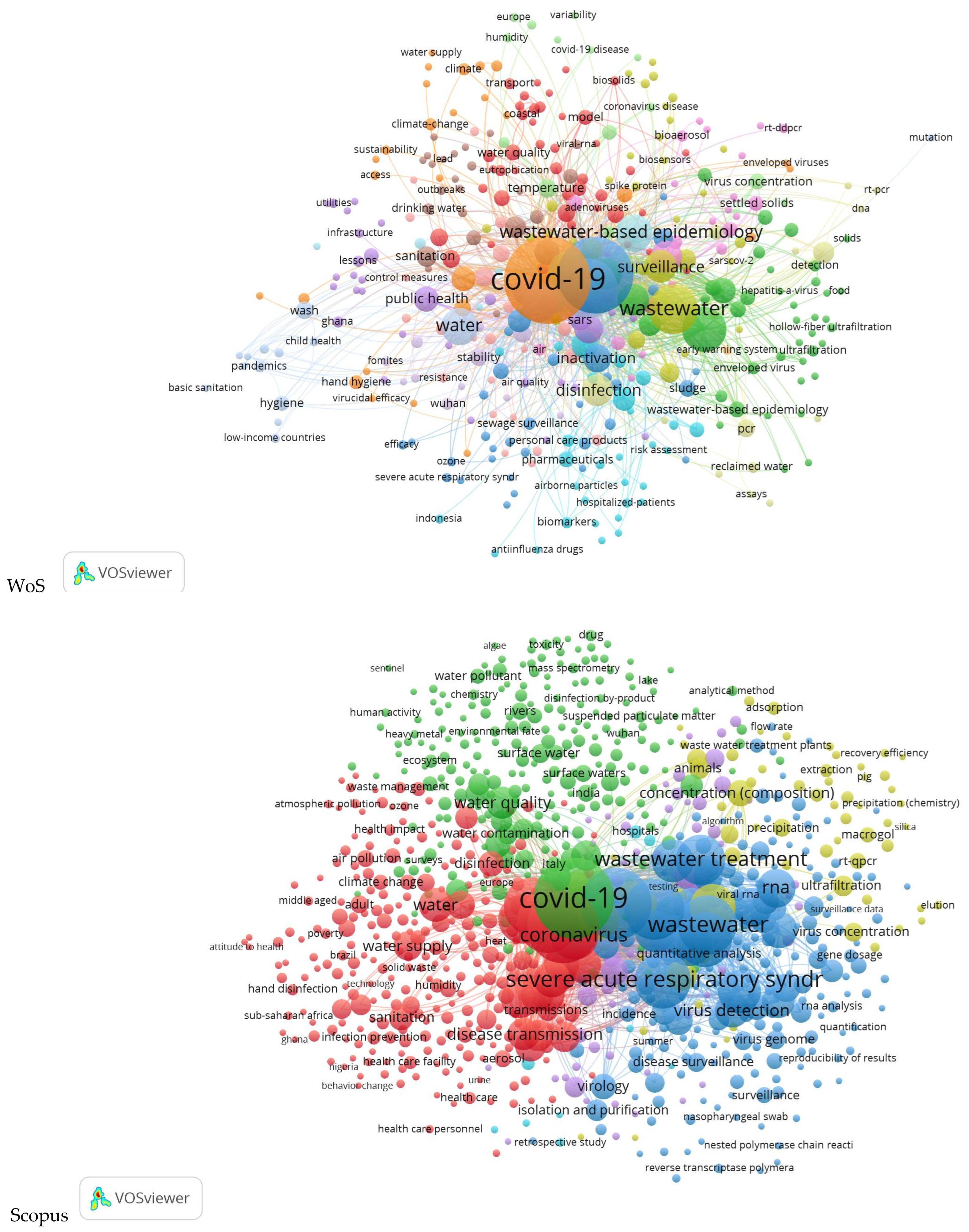


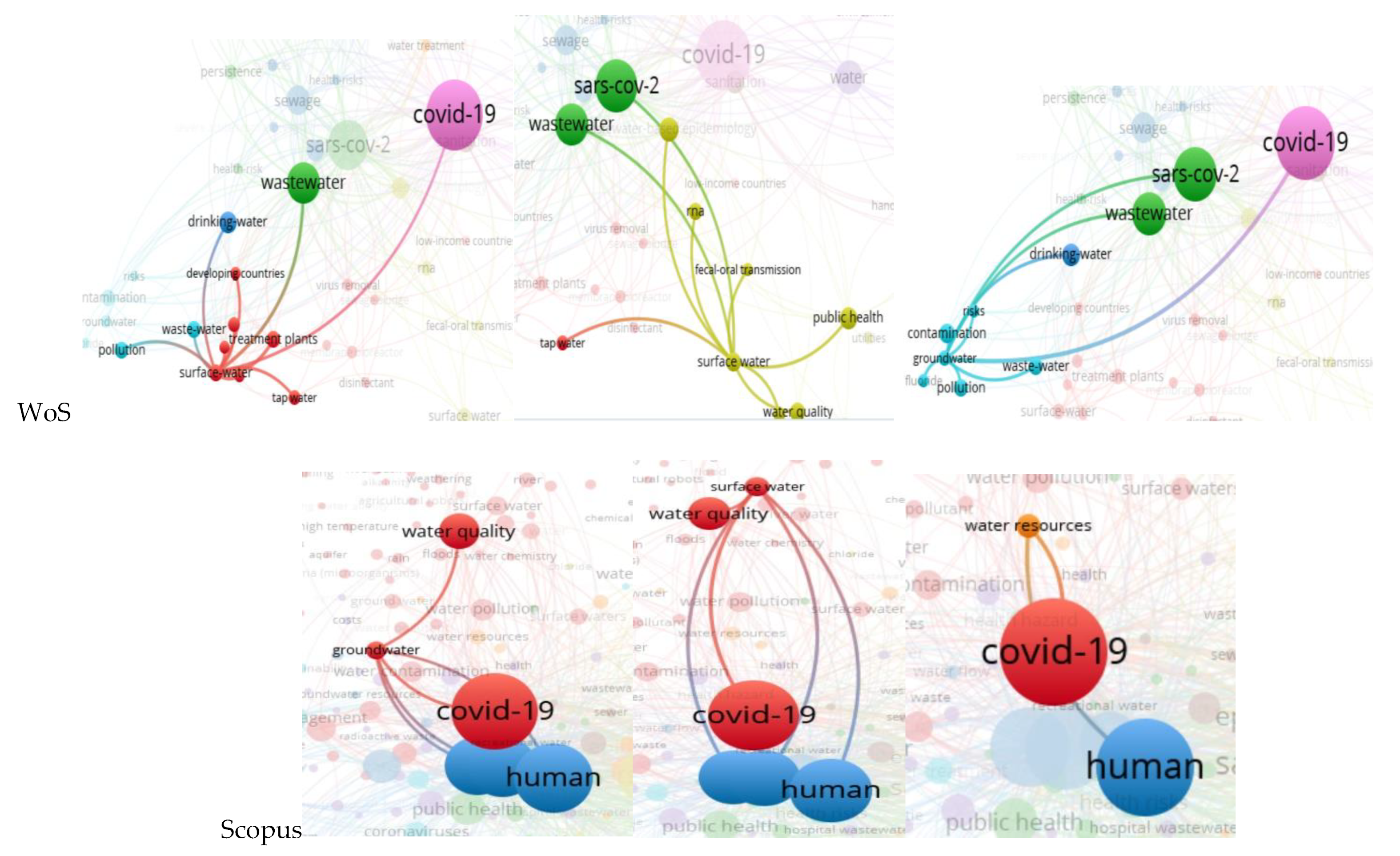
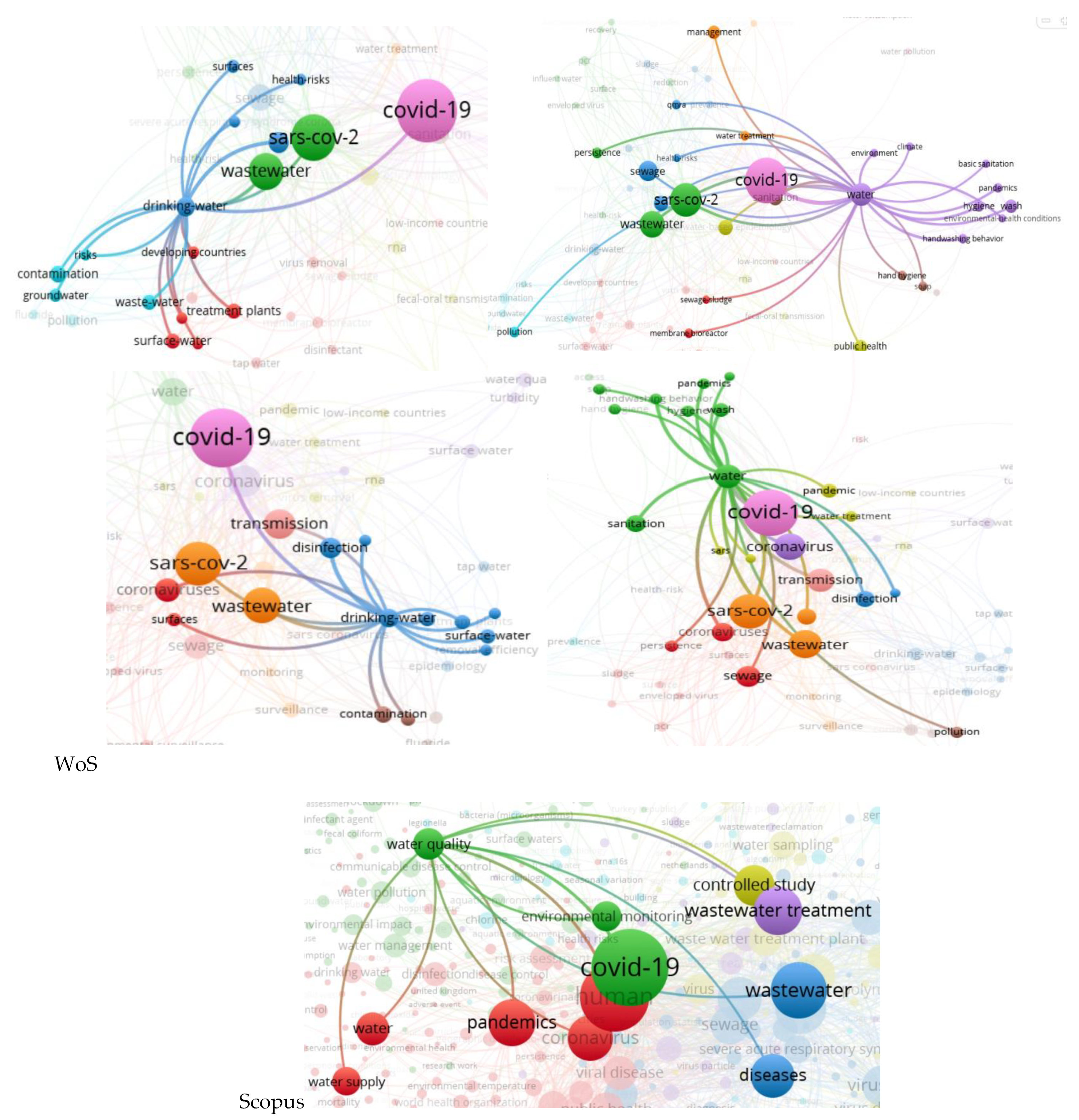
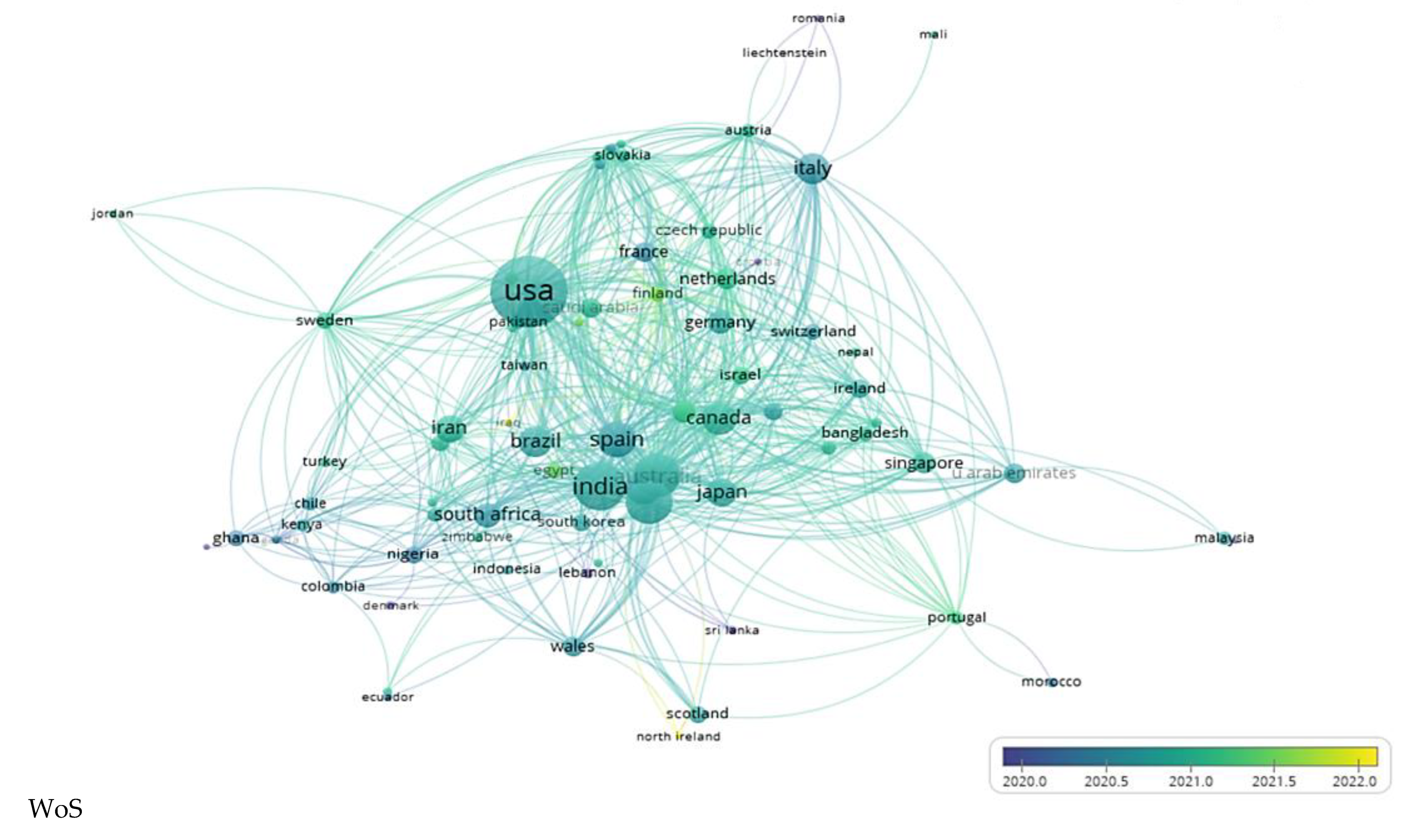
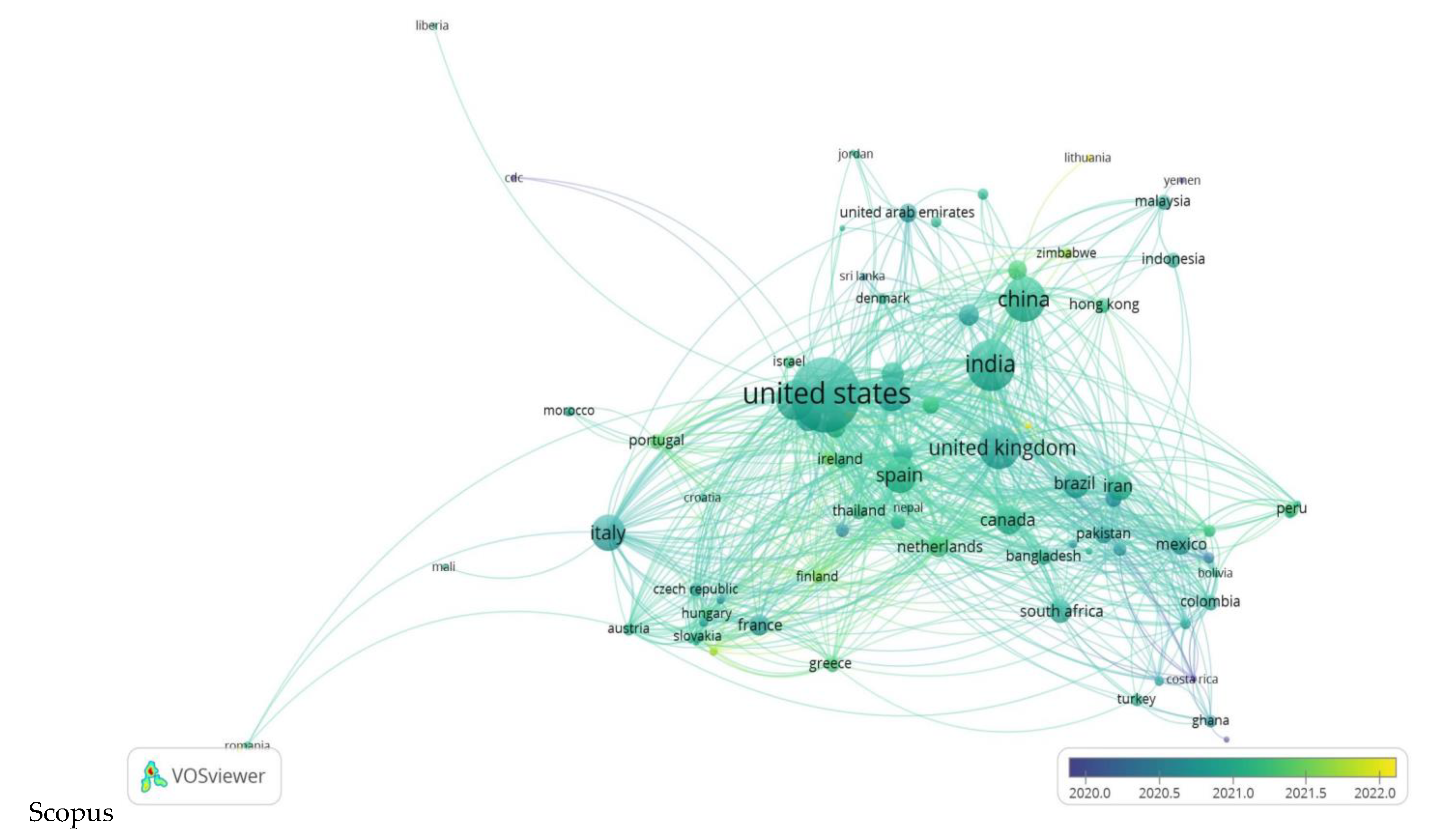
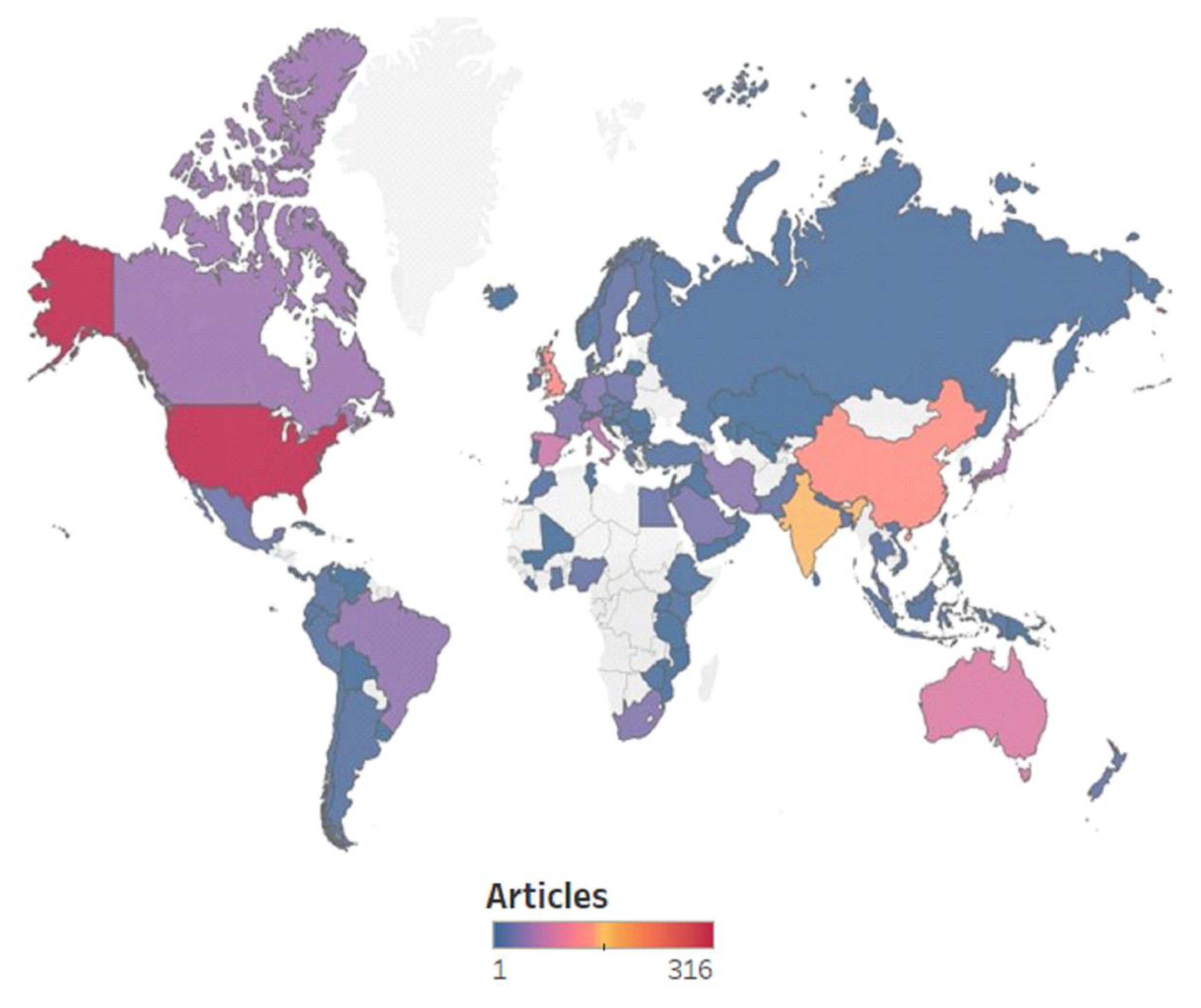
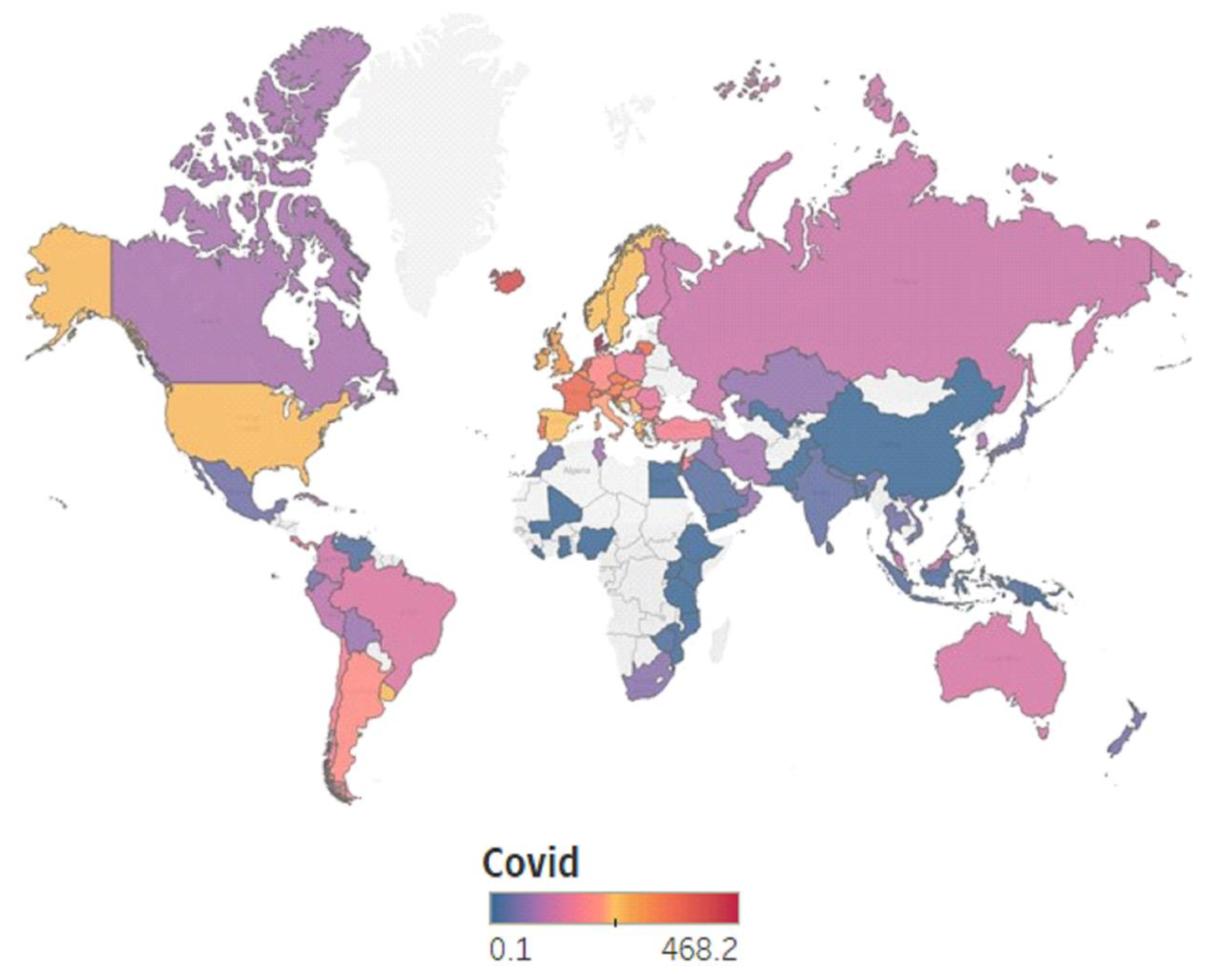
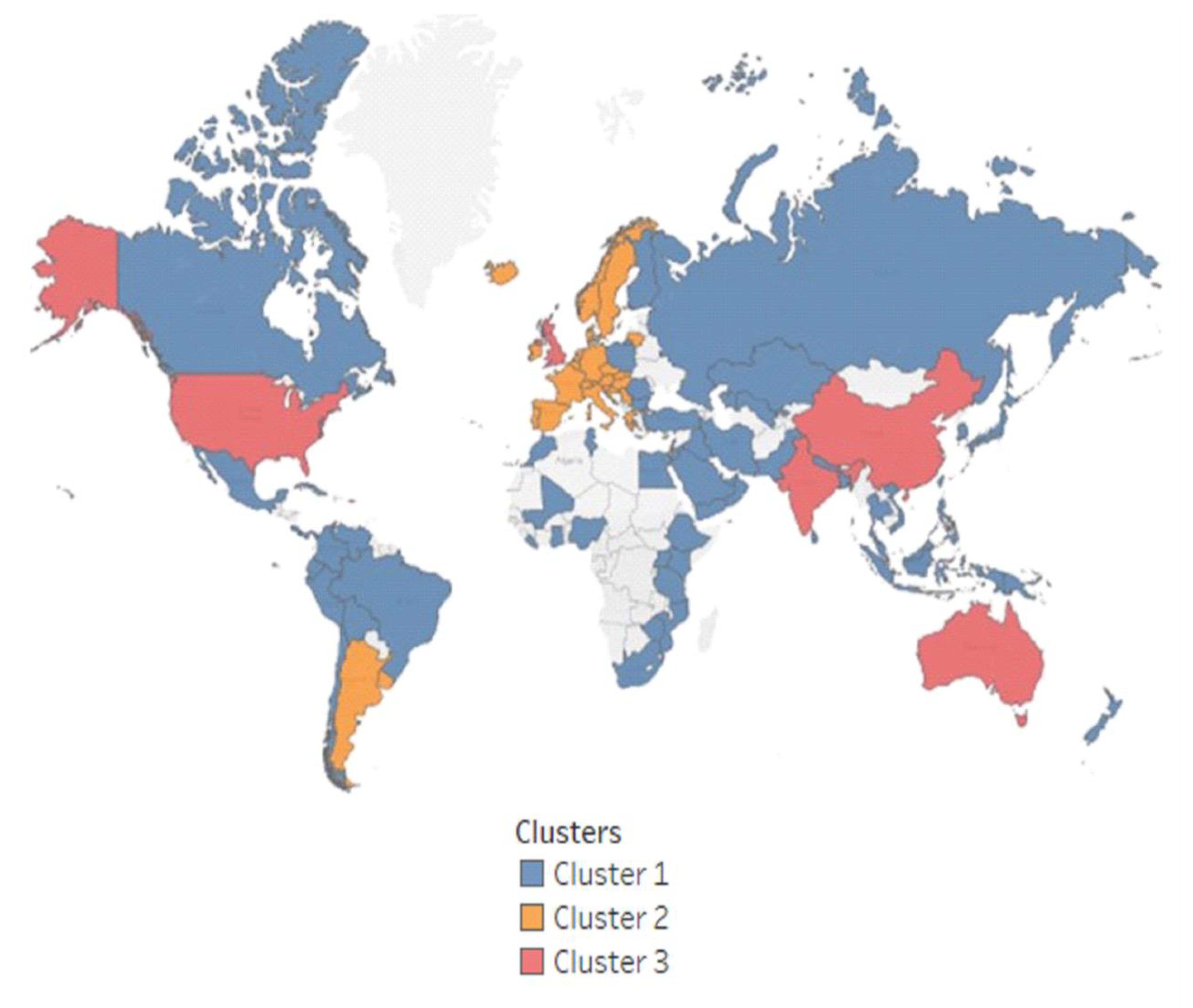
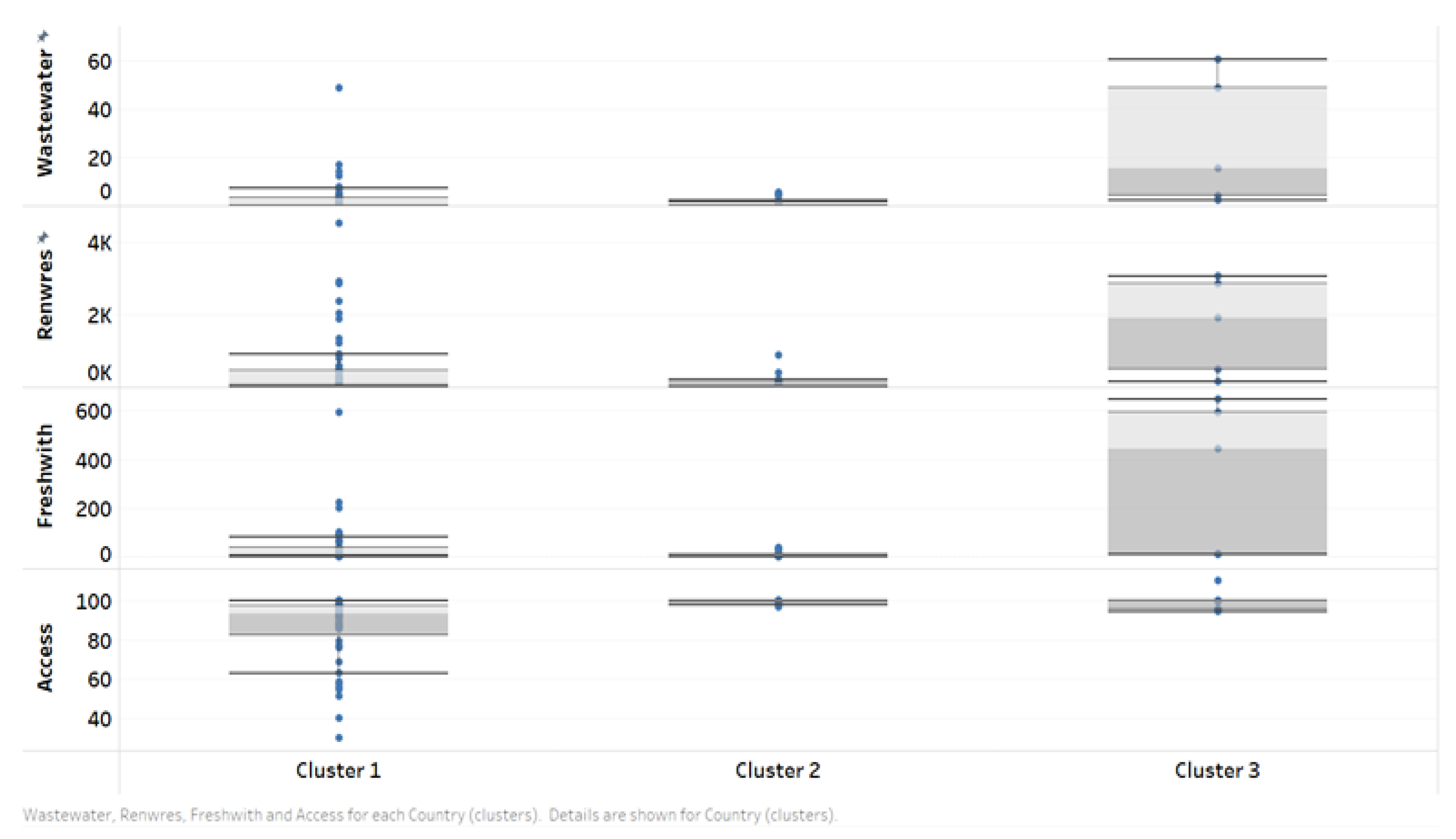

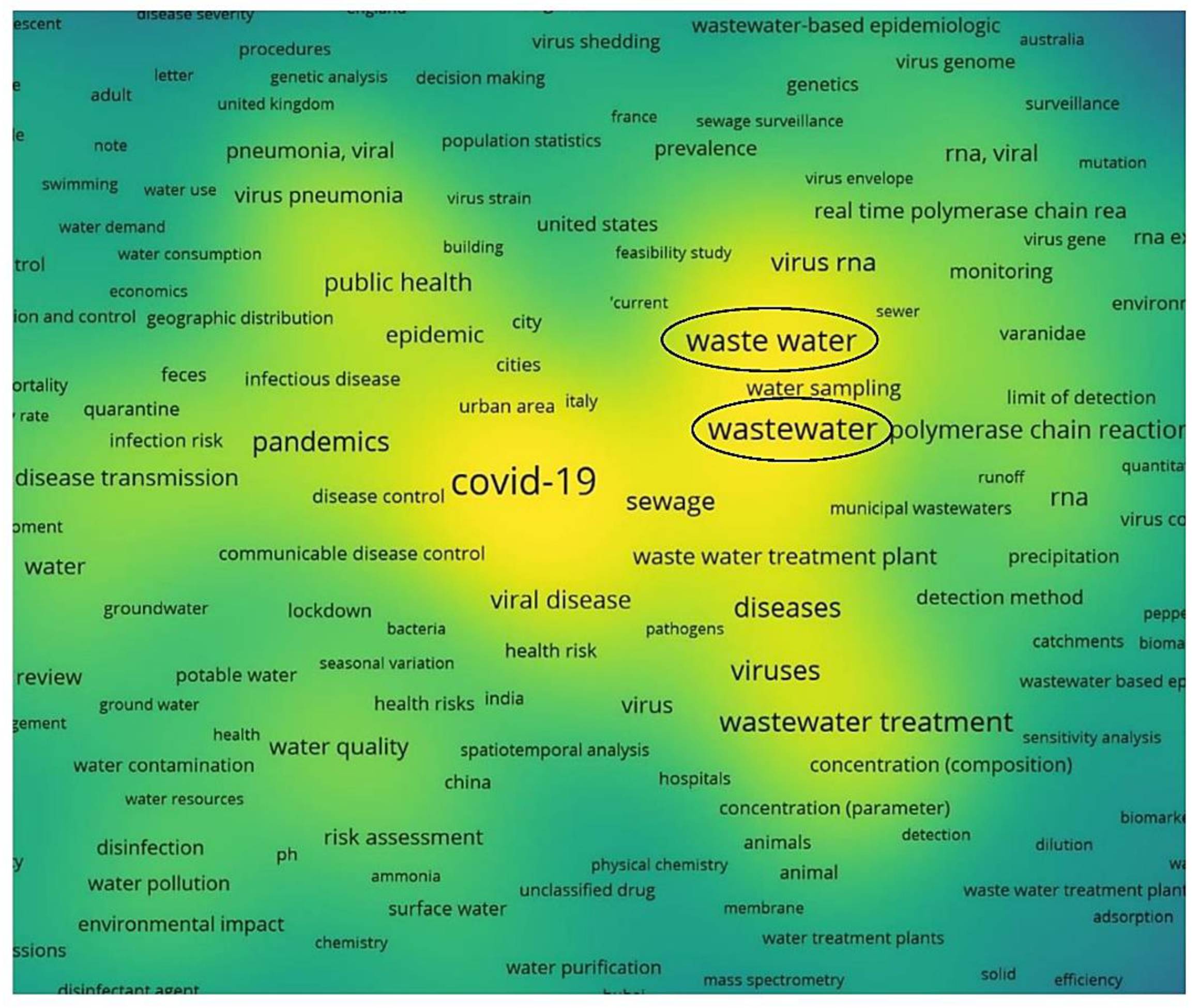
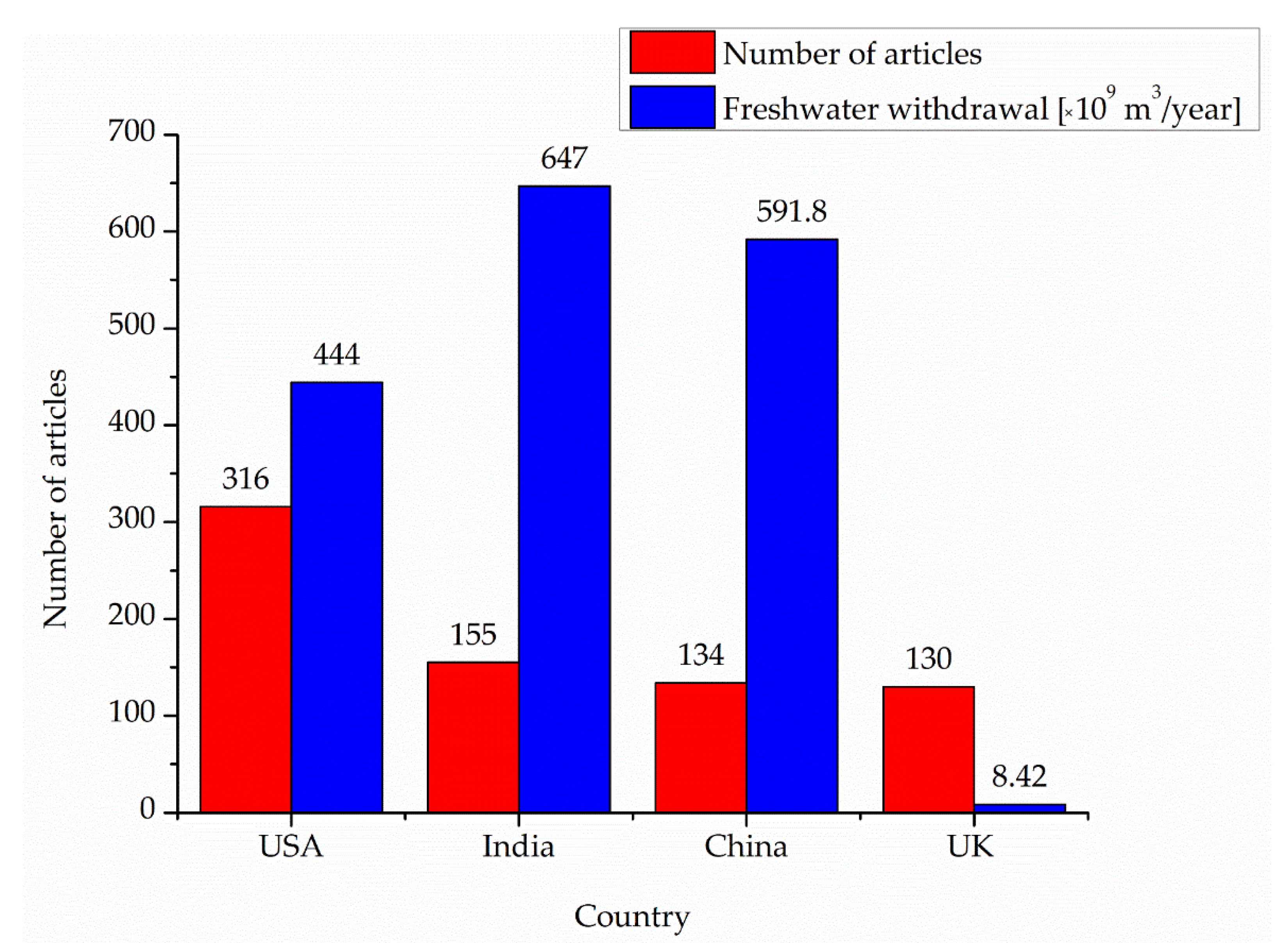
| Variable | Description and Data Source | Min | Max | Mean | St. Dev |
|---|---|---|---|---|---|
| Dependent | |||||
| Articles | The total number of articles published per country. It represents the number of articles published by authors from a country on the Web of Science (WoS) or Scopus that have specific themes related to water vs. COVID-19. The articles were exhaustively included in the database, avoiding double counting for the ones present in both databases. | 1 | 316 | 20.89 | 41.52 |
| Larticles | Natural logarithm of Articles. | 0 | 5.76 | 2.09 | 1.34 |
| Factors | |||||
| COVID | COVID-19 incidence rate, computed by the authors as the total number of COVID-19 cases/1000 inhabitants in each country based on data provided by worldometers.info/coronavirus on 7 March 2022. | 0.077 | 468.16 | 138.3 | 123 |
| LCOVID | Natural logarithm of COVID. | −2.56 | 6.15 | 4.1 | 1.82 |
| Wastewater | “Produced municipal wastewater (109 m3/year). Produced municipal wastewater represents the annual volume of domestic, commercial and industrial effluents, and storm water runoff, generated within urban areas” 1 [38]. | 0.0006 | 7468 | 83.04 | 769.9 |
| Lwastewater | Natural logarithm of Wastewater | −7.42 | 8.92 | −0.29 | 2.2 |
| Renwres | “Total renewable water resources (109 m3/year). Total renewable water resources (TRWR) represent the sum of internal renewable water resources (IRWR) and external renewable water resources (ERWR). It corresponds to the maximum theoretical yearly amount of water available for a country at a given moment” 1 [39]. | 0 | 8647 | 520.1 | 1181.86 |
| Lrenwres | Natural logarithm of Renwres | −2.85 | 9.06 | 4.28 | 2.61 |
| Freshwith | “Total freshwater withdrawal (109 m3/year) refers to the sum of surface water withdrawal, that is extracted from rivers, lakes and reservoirs, and groundwater withdrawal extracted from aquifers” 1 [40]. | 0.011 | 647.5 | 45.15 | 118.12 |
| Lfreshwith | Natural logarithm of Freshwith | −4.51 | 6.47 | 1.89 | 2.19 |
| Access | “Total population with access to improved or safe drinking water source (%). It represents the percentage of the total population using improved water sources. An “improved” source is one that is likely to provide “safe” water, such as a household connection, a borehole, etc. Current information does not allow yet to establish a relationship between access to safe water and access to improved sources, but WHO and UNICEF are examining this relationship. Safe drinking water is water that contains no biological or chemical pathogen at a level of concentration that is directly harmful to health. This includes treated, untreated, uncontaminated surface water, such as protected boreholes, springs and sanitary wells. The waters of rivers and lakes can only be considered healthy if water quality is regularly monitored and considered acceptable by public health officials. Reasonable access to water means a water supply in the water housing or within a 15-min walk of it” 1 [41]. | 30 | 110 | 92.16 | 14.26 |
| Control | |||||
| HDI | “Human Development Index, computed by the United Nations. The Human Development Index (HDI) is a summary measure of average achievement in key dimensions of human development: a long and healthy life, being knowledgeable and have a decent standard of living. The HDI is the geometric mean of normalized indices for each of the three dimensions” 2 [42]. | 0.434 | 0.957 | 0.790 | 0.138 |
| GDP_cap | “GDP per capita on 30 June 2021, according to World Bank. GDP per capita is gross domestic product divided by midyear population. GDP is the sum of gross value added by all resident producers in the economy plus any product taxes and minus any subsidies not included in the value of the product. It is calculated without making deductions for depreciation of fabricated assets or for depletion and degradation of natural resources. Data are in current U.S. dollars” 3 [43]. | 448.6 | 17,5813.9 | 21,581.8 | 26,537.3 |
| LGDPcap | Natural logarithm of GDP_cap | 6.11 | 12.08 | 9.2 | 1.39 |
| LCOVID | Lwastewater | Lrenwres | Lfreshwith | Access | LGDPcap | HDI | |
|---|---|---|---|---|---|---|---|
| LCOVID | 1 | ||||||
| Lwastewater | 0.057 (0.5839) | 1 | |||||
| Lrenwres | −0.104 (0.322) | 0.548 (0.000) | 1 | ||||
| Lfreshwith | −0.229 (0.027) | 0.740 (0.000) | 0.661 (0.000) | 1 | |||
| Access | 0.622 (0.000) | 0.296 (0.004) | −0.009 (0.929) | 0.120 (0.248) | 1 | ||
| LGDPcap | 0.684 (0.000) | 0.204 (0.048) | −0.167 (0.109) | −0.152 (0.143) | 0.672 (0.000) | 1 | |
| HDI | 0.751 (0.000) | 0.269 (0.009) | −0.114 (0.277) | −0.036 (0.731) | 0.767 (0.000) | 0.948 (0.000) | 1 |
| Actions | Methods/Ways | References |
|---|---|---|
| Detection |
|
|
|
| |
|
| |
|
| |
|
| |
|
| |
|
| |
|
| |
|
| |
|
| |
| Surveillance/monitoring |
|
|
|
| |
|
| |
|
| |
|
| |
| Recovery of COVID-19 particles |
|
|
|
| |
|
| |
|
| |
|
| |
| Prevention |
|
|
|
| |
|
| |
|
| |
| Determination of microbial risks |
|
|
|
| |
| Determination of the real number of COVID-19 cases |
|
|
| Cluster | No. of Countries | Centers—Average | |
|---|---|---|---|
| Articles | COVID | ||
| 1 | 61 | 11.7 | 67.02 |
| 2 | 28 | 14.9 | 293.9 |
| 3 | 5 | 165.4 | 136.3 |
| ANOVA | |||
| BSS | 5.62 | ||
| WSS | 2.41 | ||
| TSS | 8.04 | ||
| Cluster | No. of Countries | Centers—Average | |||||
|---|---|---|---|---|---|---|---|
| Articles | COVID | Wastewater | Renwres | Freshwith | Access | ||
| 1 | 49 | 11.76 | 47.25 | 2.32 | 493.03 | 31.44 | 85.5 |
| 2 | 40 | 18.15 | 255.4 | 1.3 | 135.6 | 9.07 | 99.7 |
| 3 | 4 | 153 | 83.7 | 43.2 | 2665.1 | 568.9 | 97.2 |
| 4 | 1 | 44 | 135.1 | 7468 | 8647 | 65.7 | 98.1 |
| ANOVA | |||||||
| BSS | 10.84 | ||||||
| WSS | 5.98 | ||||||
| TSS | 16.82 | ||||||
| Variables | Equation (1) | Equation (2) | Equation (3) | Equation (4) |
|---|---|---|---|---|
| LCOVID | 0.029 (0.051) | 0.096 (0.087) | 0.159 ** (0.065) | −0.13 (0.103) |
| Lwastewater | 0.398 *** (0.073) | - | - | - |
| Lrenwres | - | 0.179 ** (0.051) | - | - |
| Lfreshwith | - | - | 0.373 *** (0.05) | - |
| Access | - | - | - | 0.038 *** (0.013) |
| Constant | 2.09 *** (0.242) | 0.961 *** (0.431) | 0.737 ** (0.291) | −0.9 (0.936) |
| R2 | 0.4305 | 0.1302 | 0.3557 | 0.1073 |
| F (Prob > F) | 15.15 (0.000) | 7.03 (0.002) | 30.92 (0.000) | 5.09 (0.008) |
| Variables | Equation (1.1) | Equation (1.2) | Equation (2.1) | Equation (2.2) | Equation (3.1) | Equation (3.2) | Equation (4.1) | Equation (4.2) |
|---|---|---|---|---|---|---|---|---|
| LCOVID | −0.128 * (0.066) | −0.128 (0.084) | −0.219 *** (0.068) | −0.252 *** (0.081) | −0.092 (0.072) | −0.085 (0.099) | −0.253 ** (0.099) | −0.285 ** (0.076) |
| Lwastewater | 0.366 *** (0.071) | 0.358 *** (0.072) | - | - | - | - | - | - |
| Lrenwres | - | - | 0.211 *** (0.041) | 0.191 *** (0.044) | - | - | - | - |
| Lfreshwith | - | - | - | - | 0.371 *** (0.05) | 0.335 *** (0.053) | - | - |
| Access | - | - | - | - | - | - | 0.024 * (0.013) | 0.016 (0.014) |
| LGDPcap | 0.305 *** (0.112) | - | 0.627 *** (0.112) | - | 0.480 *** (0.103) | - | 0.373 ** (0.167) | - |
| HDI | - | 2.82 ** (1.262) | - | 6.176 *** (1.161) | - | 4.123 *** (1.248) | - | 4.608 ** (1.976) |
| Constant | −0.083 (0.883) | 0.494 (0.762) | −3.64 *** (0.917) | −2.546 ** (0.733) | −2.649 *** (0.768) | −1.451 ** (0.661) | −2.48 ** (1.09) | −1.899 ** (0.880) |
| R2 | 0.4809 | 0.4628 | 0.3471 | 0.3096 | 0.4872 | 0.4304 | 0.1718 | 0.1721 |
| F (Prob > F) | 12.32 (0.000) | 13.24 (0.000) | 18.62 (0.000) | 7.43 (0.000) | 6.04 (0.000) | 23.38 (0.000) | 6.01 (0.000) | 6.74 (0.000) |
Disclaimer/Publisher’s Note: The statements, opinions and data contained in all publications are solely those of the individual author(s) and contributor(s) and not of MDPI and/or the editor(s). MDPI and/or the editor(s) disclaim responsibility for any injury to people or property resulting from any ideas, methods, instructions or products referred to in the content. |
© 2023 by the authors. Licensee MDPI, Basel, Switzerland. This article is an open access article distributed under the terms and conditions of the Creative Commons Attribution (CC BY) license (https://creativecommons.org/licenses/by/4.0/).
Share and Cite
Mare, R.; Mare, C.; Hadarean, A.; Hotupan, A.; Rus, T. COVID-19 and Water Variables: Review and Scientometric Analysis. Int. J. Environ. Res. Public Health 2023, 20, 957. https://doi.org/10.3390/ijerph20020957
Mare R, Mare C, Hadarean A, Hotupan A, Rus T. COVID-19 and Water Variables: Review and Scientometric Analysis. International Journal of Environmental Research and Public Health. 2023; 20(2):957. https://doi.org/10.3390/ijerph20020957
Chicago/Turabian StyleMare, Roxana, Codruța Mare, Adriana Hadarean, Anca Hotupan, and Tania Rus. 2023. "COVID-19 and Water Variables: Review and Scientometric Analysis" International Journal of Environmental Research and Public Health 20, no. 2: 957. https://doi.org/10.3390/ijerph20020957
APA StyleMare, R., Mare, C., Hadarean, A., Hotupan, A., & Rus, T. (2023). COVID-19 and Water Variables: Review and Scientometric Analysis. International Journal of Environmental Research and Public Health, 20(2), 957. https://doi.org/10.3390/ijerph20020957







